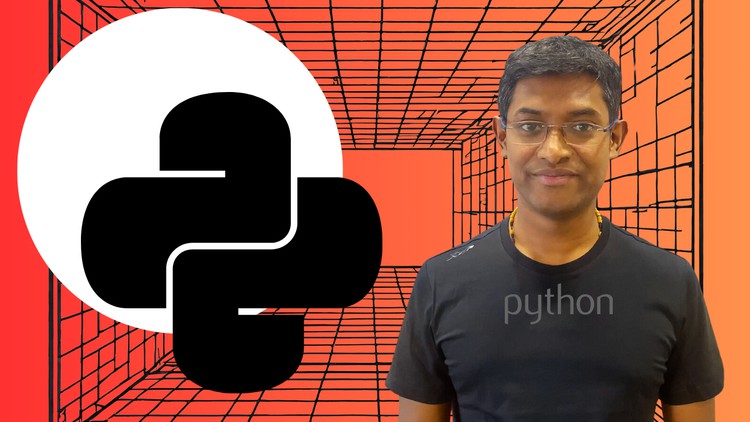Dynamic Programming, Backtracking, Knowledge Constructions, BigO,Query Patterns,In depth Explanations. Get the job you need !
Day 1: Arrays Knowledge Constructions and Algorithms
What you’re going to get from this course
Welcome! Tips on how to make finest use of this course (Please Watch)
Day 1 Targets
Introduction to Knowledge Constructions
Introduction to Large O, Time Complexity
2 Asymptotic Evaluation and Large O
Large O Area Complexity
Large O Logarithm
Arrays: Knowledge Constructions Crash Course
Quiz: Arrays
CODING EXERCISES
CODING INTERVIEW Q1 (Straightforward): Sorted Squared Array
Coding Train: Sorted Squared Array
Methodology 1, Large O Evaluation
Python Code – Methodology 1
Methodology 2
Python Code – Methodology 2
CODING INTERVIEW Q2 (Straightforward): Monotonic Array
Coding Train: Monotonic Array
Methodology and Large O evaluation
Python Code – Monotonic Array
Day 2: Recursion
Day 2 Targets
Recursion Fundamentals
Recursive Leap of Religion
Visualising Recursion
Recursion vs Iteration
Methods to put in writing Base situation
Recurrence relation
Tips on how to Remedy Recursion Questions
Recursion Approaches – 0 to N and N to 0
Recursion is in every single place
Complexity Evaluation of Recursive Options
Quiz: Recursion
CODING INTERVIEW QUESTION (Medium): k-th image in Grammar
Coding Train (k-th image in Grammar)
Strategy(k-th image in Grammar)
Pseudocode (k-th image in Grammar)
Python Code
Complexity Evaluation(k-th image in Grammar)
Python Resolution (k-th image in Grammar)
CODING INTERVIEW QUESTION (Medium): Josephus drawback
Coding Train: Josephus drawback
Strategy 1
Pseudocode
Complexity Evaluation
Python Resolution 1: Josephus drawback Methodology 1
Strategy 2
Pseudocode
Complexity Evaluation
Python Resolution 2 : Josephus drawback Methodology 2
Strategy 3
Complexity Evaluation
Python Resolution 3 : Josephus drawback Methodology 3
Day 3: Recursion Continued
Day 3 Targets
CODING INTERVIEW QUESTION (Medium): Tower of Hanoi
Coding Train(Tower of Hanoi)
Figuring out that wew can use Recursion
Strategy
Recursion Tree
Python Resolution : Tower of Hanoi
Complexity Evaluation : Tower of Hanoi
CODING INTERVIEW QUESTION(Medium): Energy Sum
Coding Train: Energy Sum
Methodology and Large O Evaluation
Python Resolution: Energy Sum
Day 4: Backtracking
Day 4 Targets
What’s Backtracking
How is it completely different from Recursion ?
How does Backtracking work ?
Cross by reference / change inplace
Blueprint to resolve questions utilizing Backtracking
Establish when to make use of Backtracking
Quiz: Backtracking
CODING INTERVIEW QUESTION (Medium): Permutations
Coding Train ( Permutations)
Strategy
Pseudocode
Python Resolution : Permutations
Complexity Evaluation
CODING INTERVIEW QUESTION(Medium): Permutations 2
Permutations 2
Strategy
Pseudocode
Python Code: Permutations 2
Complexity Evaluation : Permutations 2
Day 5: Backtracking
Day 5 Targets
CODING INTERVIEW QUESTION(Medium): Subsets
Subsets
Methodology
Subsets – Comparability with Backtracking Blueprint
Subsets – Complexity Evaluation
Python Code – Subsets
CODING INTERVIEW QUESTION(Medium): Subsets 2
Coding Train: Subsets 2
Strategy
Python Code: Subsets 2
Subsets 2: Complexity Evaluation
Day 6: Backtracking
Day 6 Targets
CODING INTERVIEW QUESTION(Medium): Mixtures
Coding Train: Mixtures
Strategy
Mixtures : Complexity Evaluation
Python Code : Mixtures
Mixtures: Optimisation
Python Code: Mixtures with Optimisation
CODING INTERVIEW QUESTION ( Medium) : Mixtures Sum 1
Mixtures Sum 1
Day 7: Backtracking
Day 7 Targets
CODING INTERVIEW QUESTION (Medium): Mixtures Sum 2
Coding Train: Mixtures Sum 2
CODING INTERVIEW QUESTION ( Medium) : Mixtures Sum 3
Coding Train: Mixtures Sum 3
Day 8: Backtracking
Day 8 Targets
CODING INTERVIEW QUESTION(Onerous) : Sudoku Solver
Sudoku Solver
Strategy
Pseudocode
isValid verify for Sudoku Solver
Python Code : Sudoku Solver
Complexity Evaluation
One other method – Sudoku Solver ( Python Code)
CODING INTERVIEW QUESTION(Onerous): N Queen
Coding Train: N Queen
Strategy
Pseudocode
Python Code: N Queen
Complexity Evaluation
Day 9: Dynamic Programming
Day 9 Targets
Introduction to Dynamic Programming (DP)
Dynamic Programming – Patterns
Strategy to resolve DP(Dynamic Programming) Questions
Why writing the Recursive answer helps to put in writing the Backside up method
Figuring out Dynamic Programming Questions
Quiz: Dynamic Programming
CODING INTERVIEW QUESTION(Straightforward): Fibonacci
Coding Train: Fibonacci
Approaches
Strategy 1: Recursion
Complexity Evaluation: Strategy 1 – Recursion
Python Code – Recursion
Strategy 2: Memoization
Complexity Evaluation : Strategy 2 – Memoization
Python Code: Strategy 2 – Memoization
Strategy 3: Tabulation
Complexity Evaluation: Strategy 3 – Tabulation
Python Code: Strategy 3 – Tabulation
Strategy 4: Area Optimised Tabulation + Complexity Evaluation
Python Code: Strategy 4 -Area Optimised Tabulation + Complexity Evaluation
CODING INTERVIEW QUESTION(Straightforward): Climbing Stairs
Coding Train: Climbing Stairs
Day 10: Dynamic Programming Sort – Fibonacci
Day 10 Targets
CODING INTERVIEW QUESTION(Straightforward): Min Price Climbing Stairs
Coding Train: Minimal Price Climbing Stairs
CODING INTERVIEW QUESTION(Straightforward): Tribonacci
Coding Train: Tribonacci
Day 11: Dynamic Programming Sort – Knapsack
Day 11 Targets
CODING INTERVIEW QUESTION(Medium): 0/1 Knapsack
Coding Train: 01 Knapsack
Strategy 1: Recursion
Recursive Strategy: Pseudocode
Recursive Strategy: Complexity Evaluation
Python Code : Recursive Strategy
Strategy 2: Memoization
Memoization: Pseudocode
Python Code: Memoization
Memoization: Complexity Evaluation
Strategy 3: Tabulation
Python Code: Tabulation
Tabulation: Complexity Evaluation
Strategy 4: Area Optimised Tabulation Strategy
Python Code: Area Optimised Tabulation
Area Optimised Tabulation Strategy: Complexity Evaluation
CODING INTERVIEW QUESTION(Medium): Unbounded Knapsack
Coding Train: Unbounded Knapsack
Day 12: Dynamic Programming Sort – Knapsack
Day 12 Targets
CODING INTERVIEW QUESTION(Medium): Goal Sum
Coding Train: Goal Sum
CODING INTERVIEW QUESTION(Medium): Partition Equal Subset Sum
Coding Train: Partition Equal Subset Sum
Day 13: Dynamic Programming Sort – LCS ( Longest Widespread Subsequence)
Day 13 Targets
CODING INTERVIEW QUESTION(Medium): LCS
Coding Train: LCS ( Longest Widespread Subsequence)
Strategy 1: Recursion
Pseudocode
Recursion Tree and Complexity Evaluation
Python Code: LCS
Strategy 2: Memoization
Python Code: Memoization – LCS
Strategy 3: Tabulation
Tabulation: Complexity Evaluation
Python Code : Tabulation – LCS
Strategy 4: Area Optimised Tabulation – LCS
Python Code : Area Optimised Tabulation – LCS
CODING INTERVIEW QUESTION(Medium): Edit Distance
Coding Train: Edit Distance
Figuring out this as an LCS Sort Query
Strategy 1: Recursion
Pseudocode
Recursion: Complexity Evaluation
Python Code: Recursive Strategy(Edit Distance)
Strategy 2: Memoization
Python Code: Memoization(Edit Distance)
Strategy 3: Tabulation
Tabulation: Complexity Evaluation
Python Code: Tabulation (Edit Distance)
Strategy 4: Area Optimised Tabulation
Python Code: Area Optimised Tabulation ( Edit Distance)
Day 14: Dynamic Programming Sort – LIS ( Longest Rising Subsequence)
Day 14 Targets
CODING INTERVIEW QUESTION(Medium): Longest Rising Subsequence (LIS)
Coding Train: LIS
Strategy 1: Recursion – LIS
Recursion Tree
Complexity Evaluation – Recursion – LIS
Python Code – Recursion – LIS
Strategy 2: Memoization
Complexity Evaluation – Memoization
Python Code – Memoization – LIS
Strategy 3: Tabulation – utilizing a 2D dp array
Dry run
Complexity Evaluation – Tabulation – utilizing a 2D dp array
Python Code – Tabulation utilizing a 2D dp array – LIS
Strategy 4: Tabulation – utilizing a 1D dp array
Dry run
Complexity Evaluation- Tabulation – utilizing a 1D dp array
Python Code-Tabulation – utilizing a 1D dp array
Strategy 5: utilizing Binary Search – LIS
Half 1 – Strategy 5: utilizing Binary Search – LIS
Half 2 – Strategy 5: utilizing Binary Search – LIS
Binary Seek for this query ( refer Binary Search part for extra particulars)
Complexity Evaluation – Strategy 5: utilizing Binary Search – LIS
Python Code – Strategy 5: utilizing Binary Search – LIS
CODING INTERVIEW QUESTION(Medium): Max Size of Pair Chain
Coding Train: Max Size of Pair Chain
CODING INTERVIEW QUESTION(Onerous): Russian Doll Envelopes
Coding Train: Russian Doll Envelopes
Day 15: Dynamic Programming Sort – Hole Technique / Size clever Iteration
Day 15 Targets
Introduction to Hole Technique or Size clever Iteration
CODING INTERVIEW QUESTION(Medium): Palindromic Substrings
Palindromic Substrings
Instinct for Strategy
Indetifying this as a DP query
Strategy: Recursion with memoization
pseudocode
Filling the Memoization desk
iterate size clever
Recursion with memoization: Complexity evaluation
Python Code: Recursion with memoization
Tabulation method
Tabulation method: Complexity Evaluation
Python Code: Tabulation
CODING INTERVIEW QUESTION(Medium): Longest Palindromic Substring
Coding Train: Longest Palindromic Substring
CODING INTERVIEW QUESTION(Medium): Longest Palindromic Subsequence
Coding Train: Longest Palindromic Subsequence
Day 16: Dynamic Programming Sort – Partition Methodology
Day 16 Targets
Introduction to the Partition technique
CODING INTERVIEW QUESTION(Medium): Palindrome Partitioning
Coding Train: Palindrome Partitioning
Strategy
Pseudocode
Facet notice: Computing n C r
Complexity Evaluation
Python Code: Palindrome Partitioning
CODING INTERVIEW QUESTION(Onerous):Palindrome Partitioning 2 ( Minimal Cuts) – Onerous
Coding Train: Palindrom Partitioning 2 ( Min Cuts)
Strategy 1: Recursion
Python Code: Recursion – Palindrome Partitioning 2
Strategy 2: Memoization
Python Code: Memoization – Palindrome Partitioning 2
Tabulation – Strategy A : Palindrome Partitioning 2
Dry Run
Pseudocode
Python Code : Tabulation – Strategy A : Palindrome Partitioning 2
Complexity Evaluation
Tabulation – Strategy B : Palindrome Partitioning 2
Dry run
Pseudocode
Python Code: Tabulation – Strategy A : Palindrome Partitioning 2
Complexity Evaluation
Day 17: Dynamic Programming Sort – Partition Methodology
Day 17 Targets
CODING INTERVIEW QUESTION(Medium): Phrase Break
Coding Train: Phrase Break
CODING INTERVIEW QUESTION(Onerous): Matrix Chain Multiplication
Coding Train: Matrix Chain Multiplication
Day 18: Dynamic Programming Sort – Kadane’s Algorithm
Day 18 Targets
CODING INTERVIEW QUESTION (Medium): Max Subarray
Coding Train: Max Subarray
CODING INTERVIEW QUESTION (Medium): Most Product Subarray
Coding Train: Most Product Subarray
Day 19: Arrays Knowledge Constructions and Algorithms
Day 19 Targets
Coding Interview Q1(Medium): Rotate Array
Coding Train: Rotate Array
Methodology and Large O evaluation
PYTHON Code Resolution
Python Code Methodology 2
Coding Interview Q2(Medium): Container with most water
Coding Train: Container with most water
Methodology 1 and Large O evaluation
PYTHON Code Methodology 1
Methodology 2 and Large O evaluation
PYTHON Code Methodology 2
Day 20: Dictionaries / Hash Tables Knowledge Constructions and Algorithms
Day 20 Targets
Hash Desk: Knowledge Constructions Crash Course
Coding Interview Q1(Straightforward): Two Sum
Coding Train: Two Sum
Methodology 1, Large O evaluation
PYTHON Code
Methodology 2, Large O evaluation
PYTHON Code
Coding Interview Q2(Straightforward): Isomorphic Strings
Coding Train: Isomorphic Strings
Methodology and Large O evaluation
PYTHON Code
Day 21 : Strings Knowledge Constructions and Algorithms
Day 21 Targets
Knowledge Constructions Crash Course: Strings
Coding Interview Q1(Straightforward): First Non Repeating Character
Coding Train: First Non Repeating Character
Methodology 1 and Large O evaluation
PYTHON code
Methodology 2 and Large O evaluation
PYTHON code
Coding Interview Q2(Straightforward): Is Palindrome ?
Coding Train: Is Palindrome ?
Methodology 1 and Large O evaluation
PYTHON code
Methodology 2 and Large O evaluation
PYTHON code
Methodology 3 and Large O evaluation
PYTHON code
Day 22: Strings Knowledge Constructions and Algorithms
Day 22 Targets
Coding Interview Q1(Medium): Longest Sub string with Distinctive characters
Coding Train: Longest Sub string with Distinctive characters
Methodology and Large O evaluation
PYTHON code
Coding Interview Q2(Medium): Group Anagrams
Coding Train: Group Anagrams
technique and Large O evaluation
PYTHON code
Day 23: Looking Algorithms
Day 23 Targets
Coding Interview Q1 (Straightforward): Binary Search Algorithm
Coding Train: Binary Search Algorithm
Methodology and Large O evaluation
PYTHON Code Iterative
PYTHON Code Recursive
Coding Interview Q2(Medium): Search in rotated sorted array
Coding Train: Search in rotated sorted array
Methodology and Large O evaluation
PYTHON Code
Day 24: Looking Algorithms
Day 24 Targets
Coding Interview Q1(Medium): Seek for vary
Coding Train: Seek for vary
Methodology and Large O evaluation
PYTHON Code – Recursive
PYTHON Code – Iterative
Coding Interview Q2(Medium): Search in Matrix
Coding Train: Search in Matrix
technique and Large O evaluation
PYTHON code
Day 25: Sorting Algorithms
Day 25 Targets
Coding Interview Q1: Bubble Type Algorithm
Coding Train: Bubble Type Algorithm
Methodology and Large O evaluation
Python Code
Coding Interview Q2: Insertion Type Algorithm, Large O evaluation
Coding Train : Insertion Type Algorithm
Python code
Insertion type is a steady sorting Algorithm
Day 26: Sorting Algorithms
Day 26 Targets
Coding Interview Q1: Choice Type Algorithm, Large O evaluation
Coding Train: Choice Type Algorithm
Python Code
Coding Interview Q2: Merge Type Algorithm
Coding Train: Merge Type
Methodology and Large O evaluation
Python Code
Day 27: Sorting Algorithms
Day 27 Targets
Coding Interview Q1: Fast Type Algorithm
Coding Train: Fast Type
Optimise Time Complexity
Optimise Area Complexity
Python Code
Coding Interview Q2: Radix Type Algorithm, Large O evaluation
Coding Train: Radix Type Algorithm
Python Code
Day 28 Singly Linked Record Knowledge Constructions and Algorithms
Day 28 Targets
Knowledge Constructions Crash Course: Linked Lists
Coding Interview Q1(Medium): Design a Singly Linked Record
Coding Train: Design a Singly Linked Record
Methodology and Large O evaluation
Python Code
Coding Interview Q2: Take away Duplicates
Coding Train: Take away Duplicates
Methodology and Large O evaluation
Python Code
Day 29 Singly Linked Record Knowledge Constructions and Algorithms
Day 29 Targets
Coding Interview Q1(Straightforward): Reverse
Coding Train: Reverse SLL
Methodology and Large O evaluation
Python Code
Coding Interview Q2(Medium) : Cycle Detection
Coding Train: Cycle Detection
Methodology and Large O evaluation
Python Code
proof
Day 30 : Singly Linked Record Knowledge Constructions and Algorithms
Day 30 Targets
Coding Interview Q1(Medium): Discover duplicate quantity
Coding Train: Discover duplicate quantity
technique and Large O evaluation
Python code
Coding Interview Q2(Medium): Add 2 numbers
Coding Train: Add 2 numbers
technique and Large O evaluation
Python code
Day 31 Doubly Linked Record Knowledge Constructions and Algorithms
Day 31 Targets
Coding Interview Q1: Take away Node, Insert Node
Coding Train: Take away Node
Methodology take away
Python code: Take away
Insert Intro
Methodology Insert
Coding Train: Insert Node
Python code: Insert
Coding Interview Q2: Take away Worth, Insert at Place in Doubly Linked Record
Coding Train :Take away Worth in Doubly Linked Record
Take away Val Methodology
Python Code
Insert at Place
technique
Coding Train: Insert at Place in DLL
Python Code
Day 32: Stacks Knowledge Constructions and Algorithms
Day 32 Targets
Knowledge Constructions Crash Course: Stacks and Queues
Coding Interview Q1: Design a Stack
Coding Train: Design a Stack (with Linked Record)
Python Code
Coding Interview Q2(Medium): Reverse Polish Notation
Coding Train: Reverse Polish Notation
technique and Large O evaluation
Python Code
Day 33: Queue Knowledge Constructions and Algorithms
Day 33 Targets
Coding Interview Q1: Design a Queue
Coding Train: Design a Queue utilizing a Linked Record
Python Code
Coding Interview Q2(Straightforward) : Queue with Stack
Coding Train : Queue with Stack
technique and Large O evaluation
Python Code
Day 34: Binary Tree / Binary Search Tree Knowledge Constructions and Algorithms
Day 34 Targets
Knowledge Constructions Crash Course: Timber Introduction
Idea: Binary Timber 1
Proof : top of Balanced Binary tree is flooring(log N)
Idea: Binary Tree Terminaologies
What’s a BST – Binary Search Tree
Coding Interview Q1: Assemble Binary Search Tree,Large O evaluation
Coding Train: Assemble Binary Search Tree
Python Code
Coding Interview Q2 : Traverse – BFS and DFS,Large O evaluation
Coding Train : Traverse – BFS and DFS
Python Code
Day 35: Binary Tree / Binary Search Tree Knowledge Constructions and Algorithms
Day 35 Targets
Coding Interview Q1(Medium): Degree Order traversal
Coding Train: Occasion technique, Degree Order traversal
Insert technique
Python code
Degree Order Traversal Methodology and Large O evaluation
Python code – Degree order traversal
Coding Interview Q2(Medium): Left / Proper view
Coding Train: Left / Proper view
Methodology and Large O evaluation
Python code
Day 36: Binary Tree Knowledge Constructions and Algorithms
Day 36 Targets
Coding Interview Q1 (Straightforward): Invert Binary Tree
Iterative technique and Large O evaluation
Python Code: Iterative
Recursive technique and Large O evaluation
Python Code: Recursive
Coding Interview Q2 (Straightforward): Diameter of Binary Tree
Methodology and Large O evaluation
Python Code
Day 37: Binary Search Timber Knowledge Constructions and Algorithms
Day 37 Targets
Coding Interview Q1(Straightforward): sorted array to BST
technique and Large O evaluation
Python code
Coding Interview Q2(Medium) : Legitimate BST
Methodology and Large O evaluation
Python Code
Day 38: Heaps and Precedence Queue Knowledge Constructions and Algorithms
Day 38 Targets
Binary Heap: Knowledge Construction Crash Course
Coding Interview Q1: Assemble Max Binary Heap, Large O evaluation
Proof of Construct Binary Heap Time Complexity
Python Code
Introduction to Precedence Queue
Coding Interview Q2: Assemble Precedence Queue,Large O evaluation
Python Code
Day 39: Graphs Knowledge Constructions and Algorithms
Day 39 Targets
Coding Interview Q1: BFS, Adjacency Record,Large O evaluation
Python Code
BFS, Adjacency Matrix
Python Code
Coding Interview Q2: DFS, Recursive, Large O evaluation
Python Code
DFS Iterative
Python Code
Day 40: Graphs Knowledge Constructions and Algorithms
Day 40 Targets
Coding Interview Q1: Variety of Parts, Large O evaluation
Python Code
Coding Interview Q2(Medium): Course Scheduler
Brute Power Methodology and Large O evaluation
Python Code – Brute Power Methodology
Topological Type based mostly technique and Large O evaluation
Python Code
The submit 50Days DSA PYTHON Patterns| Algorithms| Dynamic Programming appeared first on destinforeverything.com.








